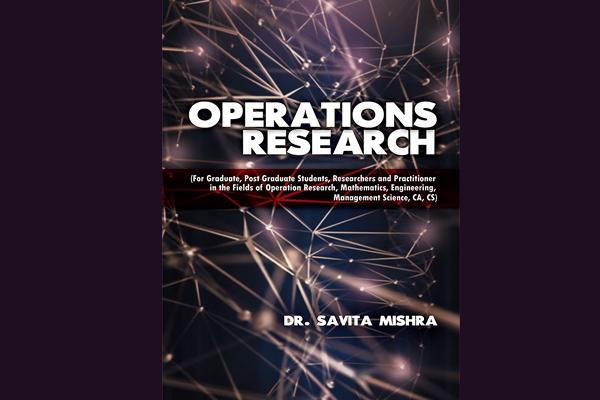 image
image
Savita Mishra decodes Operations Research in a lucid language
In 'Operations Research', Dr Savita Mishra discusses about the evolving branch of operations research (OR), a part of Applied Mathematics that is being increasingly used in various practical fields for formulating viable solutions to real-life complicated problems.
This book will interest readers from different streams, be it science or commerce, and in fact this book is a handy guide for professionals in various industries.
Every industry has its own share of problems and OR is a multidisciplinary and analytical technique that can be used to assess any problem in the company and derive mathematical models of the solutions.
Such models are made only after proper evaluation of the scope of the problem, the available resources, and the limitations.
The technique of OR was developed by none other than the revered scientist Archimedes during a military war and since then this technique has evolved and become stronger.
Now it finds application in multiple fields like manufacturing, transportation, telecommunication, financial planning, public services, health care, and military operations.
When the scale of a particular company increases, the scale of the problems increases along with it. And if a single person tries to find out a solution that solution may suffer from human errors or from lack of some personal judgements.
In order to overcome such errors that can lead to massive losses, OR is being increasingly used by the professionals these days.
This methodology helps to come up with a solution that is comprehensive, viable, and effective. Using such scientific methods to solve tricky situations can only lead to the development of the company as a whole.
This book gives us a detailed idea about this method of OR—about its origin, its significance, its applications, and most importantly about the various stages involved in this elaborate process.
OR is done in four significant steps—definition of the problem, model construction, model solution, and implementation of the solution derived from the proposed model.
Now each of these four steps also has their own features.
Since OR is an interdisciplinary subject, techniques like Linear Programming, Waiting Line or Queuing Theory, Game Theory, Inventory Control Models, Simulation, Non-linear programming, Integer Programming, Dynamic Programming, etc. are used commonly.
This book is divided into various chapters and in each chapter the author has discussed an important aspect of the OR technique.
The best feature of this book is that it can be read by people from any academic background. No one will have any problem in grasping the basic ideas of OR after reading this book.
It has been written in a very lucid and comprehensive way.
Another important thing is that even if someone who has no idea about OR reads the introduction, they will understand the significance of OR and will definitely want to know more about this very relevant topic.
Also, the subsequent chapters contain various problems and their detailed solutions.
In short, this book is on a very specialized topic and yet it will appeal to people across disciplines.
(Reviewed by Priya Das)
Top Headlines
-
News
Sona Incubations, Salem picks 17 startups for Rs 11 Mn DST investment, grant
December 30, 2025
-
News
Visva-Bharati University unveils a transformational roadmap under Vice-Chancellor Dr. Probir Kumar Ghosh
December 29, 2025
-
News
Reject Macaulayan education, reclaim Indian values: H M Bangurs big World Hindu Economic Forum pitch
December 21, 2025
-
News
Horror in Bangladesh: Hindu man lynched and set on fire amid violent protests
December 19, 2025
-
News
Buried at home: UP man arrested for killing wife, two daughters over burqa dispute
December 18, 2025
-
News
Sona College of Technology: Many academic, research and industry-linked advances in 2025
December 17, 2025
-
News
Kolkata: ICCR hosts 10th anniversary celebration of Robir Kiran
December 14, 2025
-
News
Sydney's Bondi Beach horror: Pakistani-origin man named as one of thekeysuspects
December 14, 2025
-
News
Abba Aur Main: Ek Anokhi Dastan Urdu Translation of Neelima Dalmias Memoir Launched at New Delhis Jashn-e-Rekhta Festival
December 14, 2025
-
News
Jaipur: Cultural activist Sundeep Bhutoria calls for Social Investment Policy for Non-resident Rajasthanis at Pravasi Rajasthan Divas
December 14, 2025





